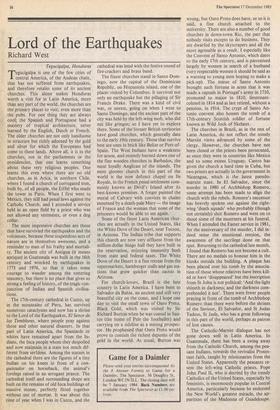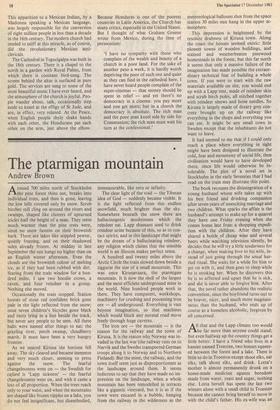Lord of the Earthquakes
Richard West
Tegucigalpa, Honduras
Tegucigalpa is one of the few cities of central America, of the Andean chain, that has not suffered from earthquakes, and therefore retains some of its ancient churches. This alone makes Honduras worth a visit for in Latin America, more than any part of the world, the churches are the primary places to visit; even more than the pubs. For one thing they are always cool; the Spanish and Portuguese had a mastery of tropical architecture, never learned by the English, Dutch or French. The older churches are not only handsome in structure but richly adorned by the gold and silver for which the Europeans had come to these lands. Above all, it is in the churches, not in the parliaments or the presidencies, that one learns something about these very religious peoples. One learns this even where there are no old churches, as in Arica, in northern Chile, where I found a church of corrugated iron, built by, of all people, the Eiffel who made the tower in Paris. When I first went to Mexico, they still had penal laws against the Catholic Church, and I attended a service held in an open field by a priest who was not allowed any vestments, or even a dog collar.
The most impressive churches are those that have survivied the earthquakes and the volcanoes, because these stupendous acts of nature are in themselves awesome, and a reminder to man of his frailty and mortali- ty. The ancient city of Antigua (it means antique) in Guatemala was built in the 16th century and wrecked by earthquakes in 1773 and 1976, so that it takes some courage to wander among the tottering masonry, but there is no place that gives so strong a feeling of history, of the tragic con- junction of Indian and Spanish civilisa- tions.
The 17th-century cathedral in Cuzco, up in the mountains of Peru, has survived numerous cataclysms and now has a shrine to the Lord of the Earthquakes, El Senor de los Temblores, where people pray against those and other natural disasters. In that part of Latin America, the Spaniards or whites have remained apart from the In- dians, the Inca people whom they despoiled and now maintain in a state not much dif- ferent from serfdom. Among the statues in the cathedral there are the figures of a tiny Indian on his knees in front of a con- quistador on horseback, the animal's forelegs raised in an arrogant prance. The cathedral itself and surrounding shops are built on the remains of old Inca buildings of massive stones, perfectly fitted together without use of mortar. It was about this time of year when I was in Cuzco, and the
cathedral was loud with the festive sound of fire-crackers and brass band.
The finest churches stand in Santo Dom- ingo, now the capital of the Dominican Republic, on Hispaniola island, one of the places visited by Columbus. It survived not only an earthquake but the pillaging of Sir Francis Drake. There was a kind of civil war, or unrest, going on when I went to Santo Domingo, and the ancient part of the city was held by the left-wing mob, who did not like gringos; so I have yet to explore there. Some of the former British territories have good churches, which generally date to the early 19th century. Those that survive best are ones in brick like Belize or Port-of- Spain. The West Indians have a weakness for arson, and recently burned down one of the fine wooden churches in Barbados, the most loyally Anglican of the islands. The most gloomy church in this part of the world is the now defunct chapel on Ile Royale, in the French penal settlement com- monly known as Devil's Island after its best-known premises. A forger painted the mural of Calvary with convicts in chains mourned by a death-pale Mary — the image of France and the woman that none of the prisoners would be able to see again.
Some of the finest Latin American chur- ches are actually in the United States, like the White Dove of the Desert, near Tucson, in Arizona. The Indian tribe that supports this church are now very affluent from the million-dollar bingo hall they have built in the reservation, enjoying immunity both from state and federal taxes. The White Dove of the Desert is a fine retreat from the supermarkets, hamburger stalls and gas sta- tions that grow quicker than cactus in Arizona.
For church-lovers, Brazil is the best country in Latin America. I have been to Salvador da Bahia, an ancient and still very beautiful city on the coast, and I hope one day to visit the small town of Ouro Preto, Black Gold, which was visited by Sir Richard Burton when he was consul in San- tos (the home of Pele the footballer) and carrying on a sideline as a mining prospec- tor. He prophesied that Ouro Preto would prove to contain the richest deposits of the gold in the world. As usual, Burton was wrong, but Ouro Preto does have, or so it is said, a fine church attached to the university. There are also a number of good churches in down-town Rio, the part that nobody visits excepts to do business. They are dwarfed by the skyscrapers and all the more agreeable as a result. I especially like the Convent of Santo Antonio, which dates to the early 17th century, and is patronised largely by women in search of a husband (very respectable women it should be said as a warning to young men hoping to make a pick-up). The statue of Santo Antonio brought such fortune in arms that it was made a captain in Portugal's army in 1710, promoted to major in 1810, lieutenant- colonel in 1814 and at last retired, without a pension, in 1914. The crypt of Santo An- tonio convent also houses the tomb of a 17th-century Scottish soldier of fortune known as Wild Jock of Skelater.
The churches in Brazil, as in the rest of Latin America, do not reflect the trendy Marxist views advanced by some of the clergy. However, the churches have not been closed or the priests been persecuted, as once they were in countries like Mexico and to some extent Uruguay. Castro has given the church a hard time in Cuba, but two priests are actually in the government in Nicaragua, which is the latest pseudo- marxist state. In El Salvador, since the murder in 1980 of Archbishop Romero, some attempt has been made to align the church with the rebels. Romero's successor has bravely spoken out against the right- wing 'death squads' who probably (though not certainly) shot Romero and went on to shoot some of the mourners at his funeral. When I attended the Easter service in 1981, for the anniversary of the murder, I did in- deed sense the emotional tension, the awareness of the sacrilege done on that spot. Returning to the cathedral last month, I found that Romero has not become a cult. There are no medals to honour him in the kiosks outside the building. A plaque has been placed over his tomb by the associa- tion of those whose relatives have been kill- ed or have 'disappeared' but the inscription from St John is not political: 'And the light shineth in darkness; and the darkness com- prehended it not'. There were fewer people praying in front of the tomb of Archbishop Romero than there were before the shrines of the Saviour, El Salvador, and St Judas Tadeus, St Jude, who has a great following in this part of the world, perhaps as patron of lost causes.
The Catholic-Marxist dialogue has not gone down well in Latin America. In Guatemala, there has been a swing away from the Catholic Church, among the pea- sant Indians, towards the revivalist Protes- tant faith, taught by missionaries from the United States. Apparently the peasants re- sent the left-wing Catholic priests. Pope John Paul II, who is decried by the trendy Catholics of the United States, especially by feminists, is enormously popular in Central America, particularly because he endorsed the New World's greatest miracle, the ap- parition of the Madonna of Guadeloupe.
This apparition to a Mexican Indian, by a Madonna speaking a Mexican language, was largely responsible for the conversion of eight million people in less than a decade in the 16th century. The modern church had tended to sniff at this miracle, as of course, did the revolutionary Mexican anti- clericals.
The Cathedral in Tegucigalpa was built in the 18th century. There is a chapel to the north in a garden with Royal Palms, from which there is constant bird-song. The screen behind the altar is surfaced in pure gold. The services are sung to some of the most beautiful music I have ever heard, and the atmosphere of the church is joyful. Peo- ple wander about, talk, occasionally step aside to kneel at the effigy of St Jude, and are, in effect, very relaxed. At the Peace, when English people shyly shake hands with each other, the Hondurans pat each other on the arm, just above the elbow. Because Honduras is one of the poorest countries in Latin America, the Church has many critics, especially in the United States. But I thought of what Graham Greene wrote from Mexico, during the time of persecution: 'I have no sympathy with those who complain of the wealth and beauty of a church in a poor land. For the sake of another peso a week, it is hardly worth depriving the poor of such rest and quiet as they can find in the cathedral here. I have never heard people complain of the super-cinemas — that money should be spent in relief — and yet there's no democracy in a cinema: you pay more and you get more; but in a church the democracy is absolute. The rich man and the poor man kneel side by side for Communion; the rich man must wait his turn at the confessional.'







































































 Previous page
Previous page